|
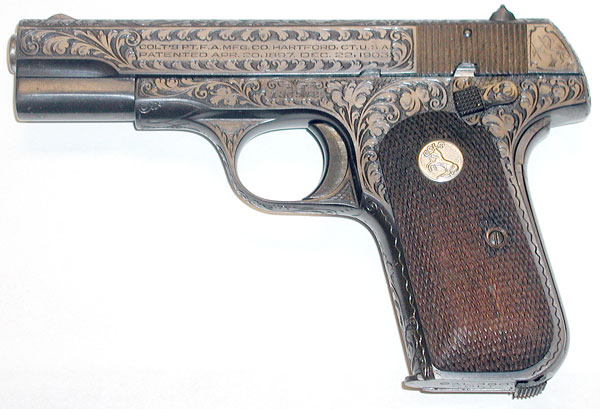
Colt Model M .380 ACP serial number 136542 issued to Brigadier General
Ralph A. Snavely. Pistol has been engraved sometime after date of issue.
General Officers did not often have their official
sidearms embellished. Engraving is a European style and was
most likely done when General Snavely was Commanding General
of Air Task Force and later 15th Army Group, both of which
are in Austria. The "U.S. PROPERTY" mark on the frame and
even the ordnance wheel on the left side of the frame behind
the thumb safety were carefully preserved by the engraver.
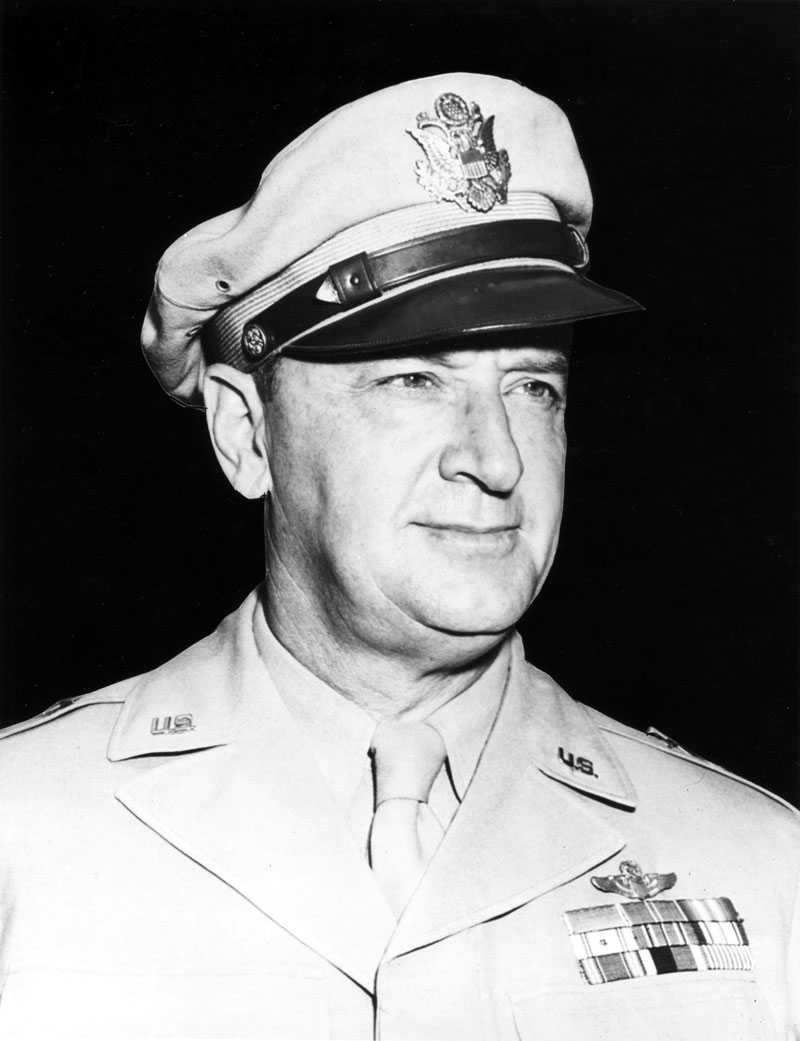
|
BRIGADIER
GENERAL RALPH A. SNAVELY, USAF (O-15100) |
| 5 January 1898 |
Born - Aurora, Missouri |
|
WORLD WAR I |
|
12 December 1918 -
15 April 1919 |
Ensign U.S. Naval Reserve Force 12 |
|
1921
 |
BA from State Teachers College,
Southwest, Missouri
Ralph Snavely, an STC student and veteran of World
War I, owned a biplane which he kept on a corner of
the football field northwest of the campus.This
information pertaining to General Snavely comes from
a chapter in a history of Missouri State University,
"Daring to Excel," by Don Landon. Snavely evidently
kept his World War I "Jenny" at what was then State
Teachers College. He later had an air strip near
Phelps Grove Park, which gave way in 1928 to the
first Springfield airport pm East Division. |
5 January 1923
9 February 1923 |
2nd Lieutenant Air Service
Accepted
Air Service Primary Flying School
Commissioned in the Air Corps in 1923 |
| 1924 |
Air Service Advanced Flying School,
Bombardment Course |
| 2 November 1927 |
1st Lieutenant Air Service |
11 March 1935 -
31 July 1935 |
Captain (temp.) |
| 1 August 1935 |
Captain |
| 1936 |
Air Corps Tactical School
Rated: Command Pilot; Combat Observer |
| 1937 |
Graduated from Command and General
Staff School |
July 1937 -
June 1938 |
Instructor at Air Corps Tactical
School |
September 1938 -
June 1939 |
Chief of the Bomb Section |
July 1939 -
June 1940 |
Instructor in Bomb Aviation |
| 11 March 1940 |
Major (temp.)
Accepted |
| 1 July 1940 |
vacated Major (temp.) |
| 1 July 1940 |
Major |
November 1940 -
May 1941 |
Instructor at the Command and
General Staff School |
7 November 1941
5 December 1941 |
Lieutenant Colonel (temp.)
Accepted |
|
WORLD WAR II |
Snavely flew in both World Wars and
according to Roy Ellis, in WW II he accumulated
several difficult assignments because he was reputed
to have conducted a commercial air service in an
area where there was at the time no air service or
airport. By the end of WW II, Snavely was a
Brigadier General in the Air Force, commanding the
entire night flight training program, and
supervising the training of pilots for the first U.
S. jet fighter, the Air Comet. |
September 1942 -
March 1943 |
Assistant Chief of Staff for
Intelligence at Fourth Air Force |
| 1943 |
Graduated from Army and Navy Staff
College |
25 March - 4 August 1943
and
8 December 1943 -
26 March 1944 |
Commanding Officer of Los Angeles
Fighter Wing [also see
Col.
Robert S. Israel, Jr, (later Brigadier General)
Commanding Officer of Los Angeles Fighter Wing,
1942] |
| April - December 1944
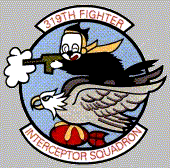 |
Commanding Officer of 319th Night
Fighter Wing
See:
The United States Army Air Force in World War II |
| November 1944 |
Brigadier General |
December 1944 -
February 1945 |
Commanding General of Air Task Force
Austria |
February 1945 -
March 1947 |
Commanding general of 15th Army
Group in Austria |
| 18 October 1948 - 20
November 1948
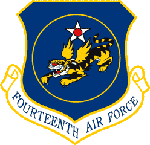 |
Fourteenth Air Force Commander
14th Air Force Flying Tigers
Vandenberg Air Force Base, CaliforniaThe
Fourteenth Air Force traces its roots to in the late
1930s when Claire L. Chennault organized a group of
American civilian volunteer pilots to fight the
Japanese in Burma and China. Throughout World War
II, the Flying Tigers (known for the distinctive
tiger shark paintings of their P-40s) compiled one
of the greatest war records against numerically
superior forces. Following a post-war series of
reorganizations and inactivations, the 14th Air
Force became the 14th Aerospace Force (AEROF) in
1968, the first command dedicated to space
surveillance and tracking. In 1993, the 14th Air
Force was restructured in its space role, becoming a
numbered Air Force for Air Force Space Command.
|
|
KOREA |
|
| July 1953 |
Retired |
| 10 February 1995 |
Died
Buried at: Section S Site 18-I
Ft. Sam Houston National Cemetery |
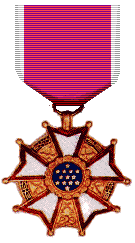 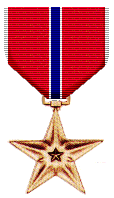 |
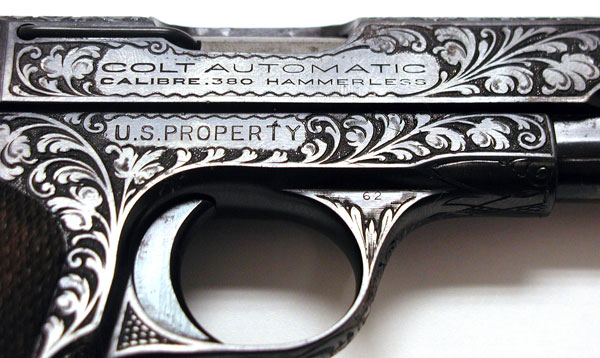
Right side close-up of markings and engraving.

Left side close-up of markings and engraving.
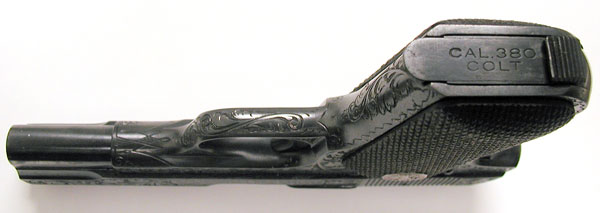
Engraving of underside of frame, trigger guard and front
grip strap.Published September 27,
2004

Pilot provided distinctive promotion
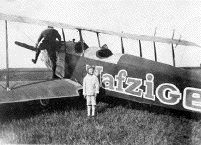
|
Nova Babb stands beside the
biplane in which he had his first plane ride in 1920
or 1921 at about age 7. Pilot Ralph Snavely is on
the wing; Nova's dad, Thomas Babb, took the photo.
The sign advertises bread.
Nova Babb

|
 Springfieldian
Nova Babb remembers seeing a biplane flown by Ralph
Snavely take off from the State Teachers College
football field in 1920 or 1921. Springfieldian
Nova Babb remembers seeing a biplane flown by Ralph
Snavely take off from the State Teachers College
football field in 1920 or 1921."He had the biplane on
blocks in the football field. Some of us kids were running
around there, and we watched him rev up the engine and
someone pulled out the blocks.
"He took off and barely cleared the trees in the
orchard," Babb said. "Later, I took a ride, sitting on my
dad's lap in the front cockpit from a field near Phelps
Grove Park."
The name "Snavely" struck a memory chord. Gen. Ralph
Snavely was mentioned often in local aviation circles.
I'd never looked into his story until Babb mentioned
riding in an open-cockpit biplane with his dad and with
Snavely at the controls.
"I was about 7 years old," Babb recalled. "We took off
from a field that I believe was south of Phelps Grove Park.
I've driven around there, but I can't figure out exactly
where it was."
Babb's father, Thomas, was dean of boys when I attended
Pipkin Junior High School in the late 1930s. The elder Babb
retired from that position. Nova Babb also taught school, in
Springfield and in New Jersey, and now is retired here.
Babb doesn't recall how much his dad paid for the 10- to
15-minute flight, which he recalls as "very interesting." He
said the view from the cockpit "was very thin there wasn't
much to see back then."
After that flight, Babb's next one was as a college
student when he took a $5 ride in a Ford tri-motor at the
old Springfield airport.
More details about Snavely come from a new book by Don
Landon, sociology professor emeritus at SMS. "Daring to
Excel," a history of the university, was a five-year labor
of love by Landon.
In a passage headed "First 'air mail' delivery in
southwest Missouri," Landon had this to say about Snavely:
"On June 21, 1921, the largest crowd ever assembled in
Springfield up to that time gathered on the State Teachers
College football field to witness the Centennial Pageant
celebrating 100 years of Missouri statehood.
"Planned and directed by Arthur Briggs, the event
featured a 1,200-voice choir and a 100-member band. ...
"But while the pageant itself was a spectacle, the manner
in which it was promoted and publicized was perhaps yet more
spectacular.
"Ralph Snavely, an STC student and veteran of World War
I, owned a biplane which he kept on a corner of the football
field northwest of the campus.
"Snavely volunteered to distribute 25,000 handbills
advertising the Centennial Pageant over southwest Missouri.
And he would do it by air!
"On Friday, June 17, Snavely climbed into his flying
machine with 25,000 handbills and several free tickets to
the pageant.
"With only 100 yards of runway space, Snavely revved the
engine, released the brake and headed down the center of the
football field. He cleared the treetops and power lines on
the east side and swerved to miss the 125-foot smokestack
beside the power house. ...
"Throughout the day, he flew at treetop level over
Monett, Nichols Junction, Brookline, Republic, Marionville,
Billings, Aurora, Verona, Sarcoxie, Mount Vernon, Miller,
Greenfield, Everton, Walnut Grove, Ash Grove, Bois D' Arc
and Springfield, dropping handbills and free tickets to
startled observers below. His only stop was in Monett where
he had lunch. ...
"Snavely was the first STC student to fly his own plane.
He flew in both world wars and according to (SMS President)
Roy Ellis, in WWII 'he accumulated several difficult
assignments because he was reputed to have conducted a
commercial air service in an area where there was at the
time no air service or airport.'
"By the end of WWII, Snavely was a brigadier general in
the Air Force, commanding the entire night flight training
program and supervised the training of pilots for the first
U.S. jet fighter."
Pilot pal Carl Warren believes the biplane in which Babb
flew was a Jenny, a World War I trainer. "They sold them in
crates as surplus after the war and you had to put them
together," Carl said. They were used widely for barnstorming
in the 1920s.
Snavely was mentioned in two "Good Old Days" columns by
Lucile Morris Upton, preserved on News-Leader microfilm.
An April 30, 1972, column mentioned that 50 years earlier
Snavely installed the city's first aircraft "filling
station" at Snavely Field near Phelps Grove.
The same day gasoline was delivered, two DeHavilland
biplanes from Oklahoma landed for refueling.
A column from March 30, 1975, told of Springfield
businessman and aviation enthusiast Ben McDonald leasing 40
acres from the Carl McCluer farm on East Division. It became
the Springfield Municipal Airport.
It was twice the size of Snavely Field. McDonald
correctly figured a bigger airport would qualify the city
for air-mail service. The airport continues under private
ownership after the "new" Springfield airport was opened in
1945.
Contact Hank Billings at
hbillings@News-Leader.com.

31st Bomb Squadron group photo in front of a
Douglas Y1B-7 with squadron commander Ralph A. Snavey
(commander from 1932 - 1934)

Douglas Y1B-7 (ca. 1949)
Missing
Plane Sighted in Alps, Says RAF Crew
Wives of 3 generals & an 11
year old girl among the passengers. Five passengers were
injured seriously as reported by a radio transmission from
the plane.
Temperature at crash site was about 20 degrees, bitter
weather & fresh snowstorm where the transport went down were
imperiling the survivors
Pilot Capt. Ralph H. Tate, JR
Crew members aboard: 2nd Lt Irving Matthews, Richmond, Va.,
co-pilot; Sgt. Souis Hill, Portales, N.M. and Staff Sgt.
Wayne G. Folsom, Postville, Ia.
All were stationed at Tullin Field, Austria.
Passengers: Brig. Gen. Loyal Haynes; Mrs. Haynes; Col.
William C. McMahon, recent chief of staff in Austria; Mrs.
McMahon and their 11 year old daughter Alice Mary; Mrs.
Ralph H. Tate, wife of Brig. Gen Ralph H. Tate; and Mrs.
Alberta Snavely, wife of Brig. Gen. Ralph Snavely, head of
the American Air Force in Austria.
Plane was on "administrative" flight from Vienna to Italy,
via Munich and Istres Field at Marseille.
~Edwardsville Intelligencer, Edwardsville, ILL; November 20,
1946
~lengthy article was abstracted by S. Ferrall
The Blue Devil;
Vol. 2, No. 24; 28 Nov 1946; pp 1,6.
The Blue Devil;
Vol. 2, No. 24; 28 Nov 1946; pp 1,6.
150 88th Div. Men Enter Switz. As Rescue
Party
All Passengers Survive Plane Crash;
Swiss Troops Effect Rescue
by Hy Crandell
Troops of the 88th Division made history last week when,
with their efforts to help rescue the marooned occupants of
a C-53 plane, they became the first foreign military troops
to enter Switzerland as a unit, in several centuries. This
is mainly due to the cooperation, mutual trust and good will
between the United States and Switzerland. By allowing over
150 American troops to enter their country the Swiss showed
that their is traditional trust and friendship between two
of the oldest democracies in the world.
Much credit is due the Swiss troops for their courageous
work in rescuing the survivors of the wrecked plane. The
88th Division troops had expected to accomplish that job,
but after arriving learned that a Swiss rescue party was
already in operation. The American troops, which came
largely from the 1st Bn., 351st Inf., left Udine on 21
November at 1900 hours, accompanied by your "Blue Devil"
reporter. After a train trip of over 24 hours they arrived
in Interlaken, Switzerland. From Interlaken a picked number
of men went by vehicle to Meiringen where they stayed all
day on 23 November. While going back to Interlaken that
night an accident occurred. A "weasel" ran through a fence
and knocked down a tree. Two men suffered slight lacerations
on the scalp. The men were Pfc Junior Rickman of Nashville,
Tenn. and Pfc Earl Funderburg of Decatur, Tenn. Both men
were from Regt'l Hq., 351st Inf.
It was thought miraculous that all the passengers of the
plane were alive and well. Due to the cold and snow and lack
of food it was expected that only a few of the stronger ones
would survive. From the time the plane crashed on Tuesday
afternoon until food was dropped on Friday night the
survivors rationed themselves to half of a chocolate bar and
a quarter of a bun a day. It was sheer luck that they had
bought their PX rations before leaving Munich.
It was announced the following day by Brig. Gen. Ralph
Tate, Deputy Commanding General of USFA [US Forces Austria],
whose wife was on the plane and whose son piloted it, that
the survivors would be brought down from the mountain by a
small ski plane. Brig. Gen Snavely, Chief of Air Division
of USFA, flew to the top of the mountain earlier that
morning so that he could be with his wife who was also on
board.
The first plane came into the airport near Meiringen at
1100 hours on 24 November. It brought Brig. Gen Loyal M.
Haynes. He was carried by stretcher to the ambulance and
then taken to the hospital train. The second plane landed at
1210 hours. On it was Pvt. Wayne G. Folsom who was the
engineer on the plane. He had a broken leg. The third plane
came in at 1318 hours. From it walked Col. William C.
McMahon and Mrs. Marguerite L. Tate. Both looked very happy
to be on the ground once more. From the fourth plane, which
landed at 1415 hours, walked Mrs. Loyal M. Haynes and Sgt.
Lewis Hill. Sergeant Hill was the radio operator who kept
the signals going after the crash. Mrs. William C. McMahon
and her daughter Alice came off the fifth plane which landed
at 1445 hours. On the sixth plane (15 minutes later) General
Snavely and his wife were passengers. Lt. Irving Mathews,
the co-pilot, and Mr. George Harvey, a civilian working for
the Army, landed in the seventh plane at 1555 hours. Mr.
Harvey was not known to be on the plane. True to the spirit
of the captain of his ship, Capt. Ralph Tate Jr. was the
last to leave and landed at 1630 hours. With the arrival of
his son, General Tate said, "This is the happiest day of my
life. I've got my wife and son back.
Before the troops of the 88th left for Switzerland, a
party of 18 men set out for Milan in the direction which had
previously been given in hopes of finding the wreckage.
Milan was the point from which communications were carried
through to Italy. It was here also that many supplies were
furnished to the 88th troops. Much credit should go to the
88th Quartermaster for the splendid job they did in rushing
supplies and equipment for the rescue party. Special clothes
and equipment were supplied the troops who participated in
the expedition to Switzerland
Source:
http://www.milhist.net/88/swiss.html
BRIGADIER GENERAL RALPH ADEL SNAVELY
Retired July 31, 1953. Died.
Ralph Adel Snavely was born in Aurora, Mo., in 1898. He
served as an ensign in the U.S. Naval Reserve from December
1918 to April 1919 and graduated from Teachers' College of
Missouri in 1921, after which he engaged in commercial
aviation.
General Snavely was appointed a second lieutenant in the Air
Service of the Regular Army Jan. 5, 1923, and assigned as a
student officer at the Air Corps Primary Flying School,
Brooks Field, Texas. After completing the course, he
transferred to the Advanced Flying School at Kelly Field,
Texas, from which he graduated with the rating of pilot in
February 1924. Retained on duty at Kelly Field, he served as
assistant engineer officer and operations officer of the
40th Squadron, and in May 1924 was assigned as flying
instructor of the 10th School Group at that station.
General Snavely went to the Philippine Islands in July 1924
and, upon completion of his two-year tour, returned to
Brooks Field as a student officer at the Flying Instructors
School. In December 1926 he was transferred to Kelly Field
where he became an instructor in the Bombardment Section of
the Advanced Flying School. In September 1930 he went to
Rockwell Field, Calif., for duty as engineering officer of
the 11th Bombardment Squadron, and in October 1931
transferred with this organization to March Field, Calif. In
June 1932, he was assigned to the 31st Bombardment Squadron,
which he commanded at various times in addition to his
duties as engineering officer.
In November 1934, General Snavely went to Maxwell Field,
Ala., as post operations and ordnance officer, and then
entered the Air Corps Tactical School there. Upon completion
of the course in June 1936 he entered the Command and
General Staff School at Fort Leavenworth, Kan. He graduated
in June 1937 and returned to Maxwell Field as an instructor.
In July 1940, General Snavely was assigned to the Office of
the Chief of Air Corps as assistant to the chief of the
Training Section. Soon afterward he was transferred to Fort
Leavenworth as an instructor at the Command and General
Staff School. He went to London, England, in May 1941 where
he became Special Assistant Army Observer at headquarters of
the Special Army Observation Group, U.S. Army Forces in the
European theater.
General Snavely became assistant chief of staff for
operations of the Fourth Air Force in San Francisco, Calif.,
in September 1942, and in March 1943 was placed in command
of the Los Angeles Air Wing. He later commanded the Los
Angeles Fighter Wing, and in May 1944 assumed command of the
410th Air Force Base Unit in Los Angeles, retaining this
position when the unit was later transferred to Hollywood,
Calif. In August 1944, he was appointed commander of the
319th Wing of the Fourth Air Force with headquarters at
Hammer Air Field, Calif.
In February 1945, General Snavely was assigned to
headquarters of the Mediterranean Allied Air Force with the
U.S. Group Control Council for Austria. He remained there
until January 1947 when he was transferred to Air Force
headquarters in Washington, D.C. On March 7, 1947, he was
appointed deputy commanding general and chief of staff of
the 11th Air Force at Harrisburg, Pa. In June 1948, he was
named vice commander of the 14th Air Force with headquarters
in Orlando Air Force Base, Fla., and retained that position
when the 14th Air Force Headquarters was moved to Warner
Robins AFB, Ga., in October 1949.
In December 1949, the general was appointed chief of the
Joint U.S. Military Advisory Group at Copenhagen, Denmark.
General Snavely's decorations include the Legion of Merit
and Bronze Star. He is rated a command pilot, combat
observer, aircraft observer, and technical observer.
(Current as of June 1952) |
 Springfieldian
Nova Babb remembers seeing a biplane flown by Ralph
Snavely take off from the State Teachers College
football field in 1920 or 1921.
Springfieldian
Nova Babb remembers seeing a biplane flown by Ralph
Snavely take off from the State Teachers College
football field in 1920 or 1921.